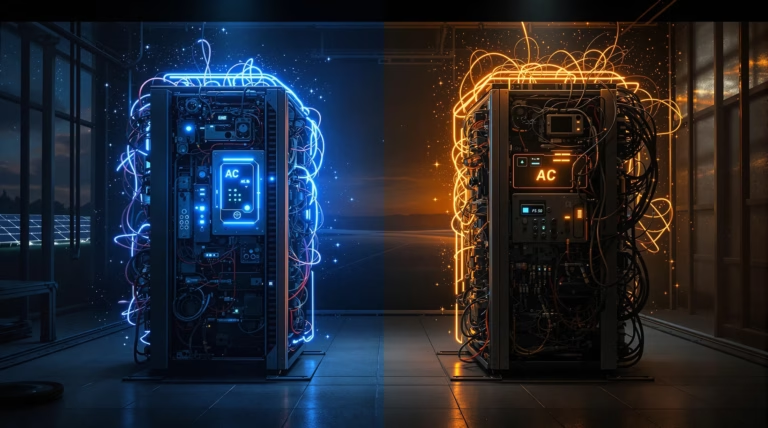Solar Battery vs Generator: Which Backup Power Solution is Best?
Looking for a reliable backup power solution for your home? The choice between solar batteries and generators can significantly impact your energy independence, costs, and environmental footprint. Let’s explore these two distinct technologies to help you make an informed decision.
Understanding Solar Batteries and Generators
Solar batteries and generators represent fundamentally different approaches to backup power. While solar batteries store renewable energy from solar panels, generators produce electricity by converting fossil fuels. This core difference shapes their functionality, cost-effectiveness, and environmental impact.
- Solar batteries – create a renewable energy cycle, storing power from solar panels
- Generators – produce electricity on demand using fossil fuels
- Environmental impact – varies significantly between the two options
- Operating costs – differ based on fuel needs versus solar energy storage
- Energy independence – levels vary depending on chosen solution
What is a Solar Battery?
A solar battery functions as an energy storage system that captures and preserves electricity generated by solar panels. Using advanced lithium-ion technology, these systems transform intermittent solar energy into a reliable power source available day and night.
| Feature | Benefit |
|---|---|
| Energy Storage | Preserves excess daytime solar production |
| Grid Independence | Reduces reliance on utility companies |
| Silent Operation | No noise pollution during use |
| Zero Emissions | Environmentally friendly power backup |
What is a Generator?
A generator converts fuel into electrical energy through mechanical combustion. These devices have been the traditional choice for backup power, offering immediate electricity production regardless of weather conditions.
- Runs on various fossil fuels (diesel, propane, natural gas, gasoline)
- Provides continuous power as long as fuel is available
- Requires regular maintenance and fuel replenishment
- Produces noise and emissions during operation
- Offers reliable power output in any weather
Comparing Solar Batteries and Generators
The choice between these technologies depends on your specific needs and long-term energy goals. Solar batteries excel in environmental benefits and lower operating costs, while generators offer immediate, high-output power regardless of weather conditions.
Power Capacity and Duration
Power output and duration capabilities differ significantly between these solutions:
| Aspect | Solar Battery | Generator |
|---|---|---|
| Duration | 1-3 days per charge | Continuous with fuel supply |
| Replenishment | Solar recharge daily | Requires fuel refills |
| Weather Dependency | Yes | No |
Cost Efficiency and Financial Considerations
The financial aspects reveal significant differences in both initial investment and long-term value:
- Generator initial cost: $300-$6,000 plus installation
- Solar battery system cost: $9,000-$25,000 including installation
- Generator ongoing costs: fuel, maintenance, replacements
- Solar battery benefits: reduced utility bills, minimal maintenance, available tax incentives
- Long-term savings potential: higher with solar battery systems
Installation and Maintenance
| Aspect | Solar Batteries | Generators |
|---|---|---|
| Installation | Professional installation required, complex integration with electrical system | Ranges from plug-and-play to professional installation |
| Maintenance Needs | Minimal, software updates only | Regular oil changes, filter replacements, fuel management |
| Lifespan | 5-15 years before battery replacement | Requires ongoing maintenance and parts replacement |
Solar battery systems demand professional installation by certified electricians who integrate the system with your home’s electrical infrastructure and solar panels. While the initial setup is more complex, these systems require minimal maintenance once operational – typically just periodic monitoring and occasional software updates.
Generators offer more flexibility in installation requirements. Portable models need no installation beyond placement and connection, while whole-home standby generators require professional setup including fuel lines, transfer switches, and ventilation systems. The maintenance contrast is significant:
- Solar batteries – minimal maintenance with battery replacement every 5-15 years
- Generators – regular oil changes and filter replacements
- Generators – periodic fuel management and test runs
- Generators – ongoing maintenance costs and time investment
- Solar batteries – software updates and system monitoring only
Environmental Impact of Solar Batteries and Generators
The environmental distinction between these backup power solutions is substantial. Solar batteries, working with solar panels, create a sustainable power cycle that significantly reduces carbon emissions. This renewable approach meets the growing demand for environmentally responsible power solutions without compromising reliability.
In contrast, generators depend on fossil fuels, producing greenhouse gases and pollutants during operation. This fundamental difference has real environmental implications, as evidenced by California’s increasing adoption of solar installations. The choice between renewable storage and fossil fuel consumption represents a crucial consideration for environmentally conscious homeowners.
Emissions and Sustainability
The emissions contrast between these technologies is stark. Solar batteries, paired with solar panels, create a carbon-neutral system post-installation. This renewable cycle has already contributed to reducing millions of tons of CO2 emissions annually across the United States.
Generator emissions present a significant environmental concern:
- Approximately 20 pounds of CO2 produced per gallon of gasoline consumed
- Continuous emissions throughout operational lifetime
- Additional pollutants including nitrogen oxides
- Even efficient natural gas models produce substantial emissions
- Ongoing environmental impact throughout usage
Noise and Pollution
The environmental experience extends beyond emissions to daily operation. Solar batteries function silently, with no moving parts or combustion processes, offering significant quality-of-life benefits during power outages. This silent operation proves particularly valuable in dense residential areas.
Traditional generators create multiple environmental challenges:
- Noise levels between 60-90 decibels (equivalent to vacuum cleaners)
- Potential violation of local noise ordinances during overnight operation
- Localized air pollution affecting immediate surroundings
- Possible respiratory issues with extended exposure
- Neighborhood disturbance during power outages
Choosing the Right Backup Power Solution
The selection between solar batteries and generators requires careful evaluation of your specific circumstances and energy goals. While solar batteries offer environmental benefits and potential long-term savings, generators remain viable for immediate emergency power needs or locations with limited sun exposure. Your choice should align with both immediate requirements and long-term energy independence objectives.
Assessing Your Power Needs
A thorough evaluation of your essential power requirements is crucial before investing in any backup power solution. Start by creating a comprehensive inventory of critical devices and appliances needed during an outage.
- Essential appliances to consider:
- Refrigeration systems
- Heating/cooling equipment
- Medical devices
- Lighting fixtures
- Communication tools
Calculate the combined wattage requirements to determine your minimum capacity needs. This assessment prevents both under-powering, which leaves you vulnerable during emergencies, and over-investing in unnecessary capacity.
| Usage Pattern | Recommended Solution |
|---|---|
| Frequent but short outages | Modest solar battery system |
| Extended outages during severe weather | Large battery bank or generator with substantial fuel storage |
| Areas with abundant sunshine | Solar solutions preferred |
| Limited solar potential regions | Generator systems recommended |
Budget and Long-term Savings
The financial comparison between solar batteries and generators extends well beyond initial costs:
- Generator costs:
- Portable models: Starting at $300
- Standby systems: $2,000-$6,000
- Ongoing fuel expenses
- Regular maintenance costs
- Eventual replacement needs
- Solar battery investment:
- Complete systems: $9,000-$25,000
- Free energy harvesting
- Minimal maintenance requirements
- Potential utility bill reduction
- Available tax incentives and rebates
Community Insights and Experiences
Real-world experiences from homeowners provide valuable perspectives on both solutions. Solar battery owners consistently report satisfaction with seamless, automatic transitions during outages, often not even noticing when grid power fails. They particularly value the silent operation and minimal maintenance requirements.
Generator owners, especially those with whole-home standby models, appreciate reliable performance regardless of weather conditions. However, they frequently mention challenges including:
- Noise disturbances during operation
- Regular maintenance requirements
- Fuel accessibility during widespread emergencies
- Storage and safety concerns
- Weather-related operational issues







